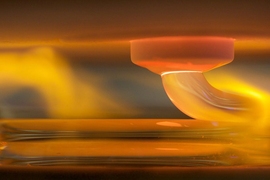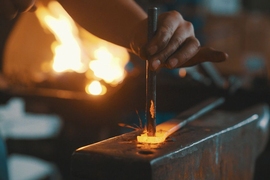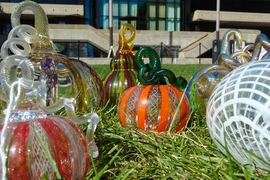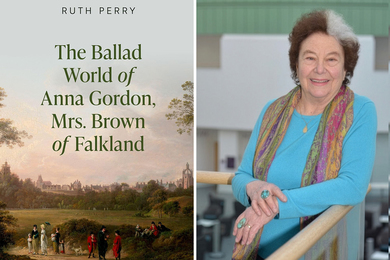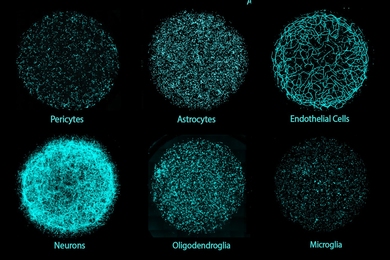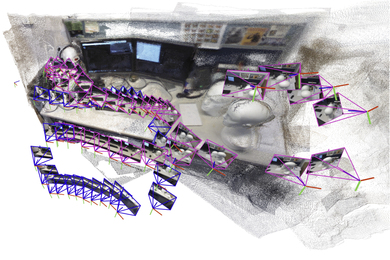Famed Italian glassmaker Lino Tagliapietra brought his team to MIT's W. David Kingery Ceramics and Glass Lab this week, turning out intricately patterned projects, both large and small, some in sunset colors, shading from orange to rust, and one suggestive of a map of the world floating in a deep blue sea.
“My goal is only experimental new things, new material; new colors are possible, new techniques, and different ways I try to do something,” Tagliapietra says.
Tagliapietra’s team included David Walters, Jen Elek, and Darin Denison, who were also assisted by MIT Glass Lab staff. It was Tagliapietra’s fifth annual visit to the Glass Lab and first since the Glass Lab reopened in January 2015 in a newly renovated space.
Tagliapietra, who began working in glass at the age of 11 in his native Murano, Italy, has become one of the world’s foremost artisans in glass during his seven decades of creative output. His vision extends beyond blown glass to fused glass panels and innovative glass sculptures shaped to resemble bats and dinosaurs. Panels draw on ideas from painting and express a range of ideas varying from cell structure to coral reefs and snow stars.
“He’s working on a series of pieces that he just started here at MIT that he’s calling the Windows of Frank Gehry, based on what he saw at the Stata Center, when he walked around the front and the back. He really admires that building,” explains MIT Glass Lab Director Peter Houk. “Usually these things that he’s doing will be done separately, in different combinations, so there are different patterns, and one has windows, and you’re looking through the windows to see a more intricate cane pattern on the inside. So I think he’s thinking of the vessel as sort of a building with windows and then a detailed interior.”
“The idea,” Tagliapietra says, “ is to do stained glass with a blown glass solid material, and fusing, give it one kind of preform, and then fuse it, [so] it becomes completely formed.”
Tagliapietra’s prior themes include “Dinosaurs,” which he has shown in abstract glass forms up to 7 feet high for a decade. He would like one day to create a dinosaur-inspired glass and metal sculpture almost 10 feet high, he says.
Master class
Tagliapietra conducted a master class for MIT Glass Lab instructors Monday through Wednesday, emphasizing the correct way to do the basic steps of collecting or “gathering” molten glass on the end of a metal rod; making a proper bubble in the glass; and shaping the glass on a metal table, or marver. No matter how creative you are, Tagliapietra says, your work won’t come out well without getting the basics right.
A half-hour to an hour of concentration on these few basic things can help you realize where you are making mistakes, Taglipietra says. Holding the pipe too close, for example, is a mistake that can result in someone getting burned if someone bumps you. “You must move in the correct way,” he says. “The balance, how you move it, you want kind of an elegant movement.”
The most basic process of gathering glass, Houk explains, is more complicated than it appears to an untrained observer. “It seems like it would be a really simple act like taking honey out of a honey jar. But it’s actually very, very complex. The way that you wind the glass onto a pipe in the furnace has everything to do with the sort of heat history of that gather when it comes out of the furnace; so if it’s uneven, the heat will be uneven. If the shape is wrong for the kind of thing that you need to do with it, it’s going to be difficult. So there is a tremendous complexity to gathering. Gathering is like the fundamental, ground zero of blowing glass. If you can’t gather correctly, you’re not going to make anything correctly,” Houk says.
The instructors also did a practice drill of shaping a bowl and adding hot glass to the rim. MIT Glass Lab director Peter Houk notes, “The bowl is secondary to the process, which is a skill building drill.”
Tagliapietra’s show, “Italian Maestro: Lino Tagliapietra, the Golden Age of Glass,” is on display at Schantz Galleries in Boston, through May 22. Tagliapietra has exhibited work at numerous galleries and museums, including an upcoming show of his panels this fall at the Philadelphia Museum of Art, and his works are held by the Metropolitan Museum of Art in New York, the Museum of Decorative Arts in Paris and the Smithsonian in Washington, among others.








